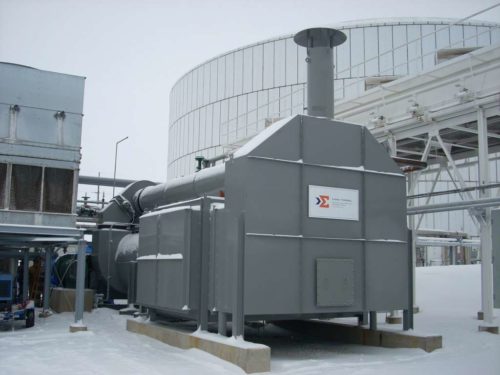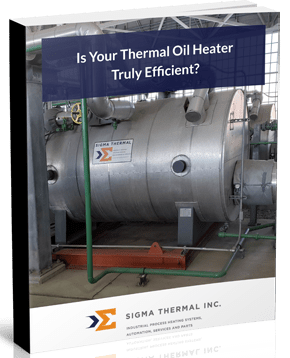Is Your Thermal Oil Heater Truly Efficient?
Calculating your thermal oil heater’s efficiency may seem simple and straightforward, but in reality, simple calculations fail to account for all of the factors that play into the heater’s efficiency. This may cause you to overestimate a thermal heater’s efficiency and force you to pay more than you bargained for over time.
To avoid this expensive mistake, make sure to educate yourself on the nuances of thermal efficiency before investing in a new oil heater. Understanding these complexities will allow you to make informed decisions regarding which efficiency level you should target.
Basic Operation of Thermal Oil Heaters
 The main advantage of thermal fluid heating is that it provides both high temperature and low pressure, making it ideal for industrial process heating applications. To achieve this temperature-pressure balance, thermal fluid heaters go through the following steps:
The main advantage of thermal fluid heating is that it provides both high temperature and low pressure, making it ideal for industrial process heating applications. To achieve this temperature-pressure balance, thermal fluid heaters go through the following steps:
- A direct-fired heater warms the thermal fluid, which is specifically designed to capture and retain heat.
- This heated thermal fluid circulates to each of the connected components in a closed loop, transferring its heat to any number of users.
- The fluid returns to the beginning of the loop for reheating, and the cycle repeats.
The chemical makeup of this fluid will vary depending on the brand and type of thermal oil heater. Water and steam are the most basic options since water has such a high heat capacity, but many modern oil heaters incorporate organic media into their circulation fluid.
Calculating Your Unique Efficiency
Many manufacturers provide an efficiency measure with their products, but these are often sweeping generalizations that may not be accurate in your specific facility. To find the most efficient option for your space, you must have an understanding of efficiency principles and how they work for your specific situation.
For energy systems like thermal oil heaters, efficiency is determined by the ratio of thermal output to energy input. Although this may sound simple, there are hundreds of elements that factor into how much effect you get out of the energy you put in. One aspect that manufacturers often neglect, for example, is the flue-gas stack temperature and how that may affect your heat loss. Heat loss from chimneys is one of the greatest sources of inefficiency in thermal oil heating systems.
To account for this oft-neglected variable, we created a simple graph that shows the efficiency as a function of stack temperature—in other words, how efficiency varies as you raise or lower the temperature. Our calculations focus on the typical heater, which has 20% excess air and a 70° F (21.1° C) ambient temperature, and control for the other variables. If you know your stack temperature or can measure it directly, this graph is an extraordinary tool to help you see the effects of your flue-gas system on your heating efficiency.
“Is Your Thermal Oil Heater Truly Efficient?” eBook, by Sigma Thermal
 Here at Sigma Thermal, we pride ourselves on developing and supplying unique process heating systems for a wide variety of industries. With an expert staff that has decades of experience, we are ready to provide an optimal solution to any and all of your heating problems.
Here at Sigma Thermal, we pride ourselves on developing and supplying unique process heating systems for a wide variety of industries. With an expert staff that has decades of experience, we are ready to provide an optimal solution to any and all of your heating problems.
For more information on the efficiency of your thermal oil heaters, check out our new eBook: “Is Your Thermal Oil Heater Truly Efficient?” Our latest eBook brings our expert knowledge directly to you. If you want to learn what goes into calculating efficiency and how to determine the efficiency of your equipment, this eBook is an excellent resource. Download your copy today!






